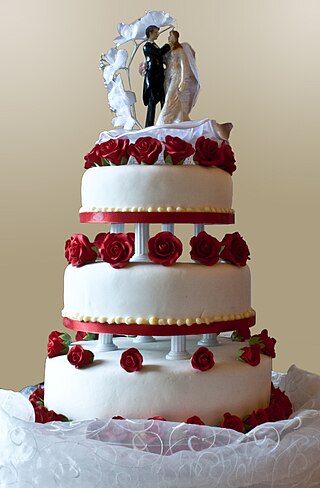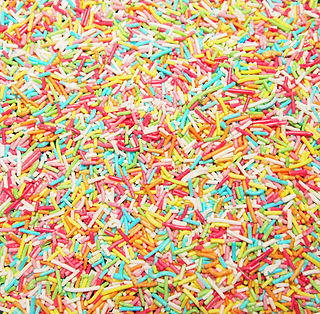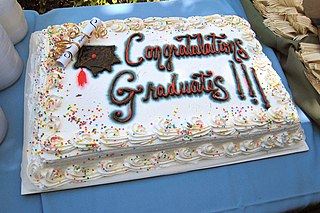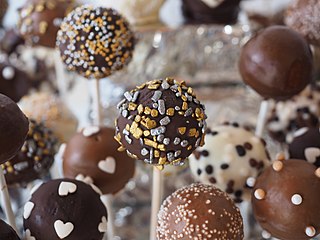
A cookie, or biscuit, is a baked snack or dessert that is typically small, flat, and sweet. It usually contains flour, sugar, egg, and some type of oil, fat, or butter. It may include other ingredients such as raisins, oats, chocolate chips, or nuts.

Confectionery is the art of making confections, which are food items that are rich in sugar and carbohydrates. Exact definitions are difficult. In general, however, confectionery is divided into two broad and somewhat overlapping categories: bakers' confections and sugar confections. The occupation of confectioner encompasses the categories of cooking performed by both the French patissier and the confiseur.

Cake is a flour confection made from flour, sugar, and other ingredients and is usually baked. In their oldest forms, cakes were modifications of bread, but cakes now cover a wide range of preparations that can be simple or elaborate and which share features with desserts such as pastries, meringues, custards, and pies.

A wedding cake is the traditional cake served at wedding receptions following dinner. In some parts of England, the wedding cake is served at a wedding breakfast; the 'wedding breakfast' does not mean the meal will be held in the morning, but at a time following the ceremony on the same day. In modern Western culture, the cake is usually on display and served to guests at the reception. Traditionally, wedding cakes were made to bring good luck to all guests and the couple. Nowadays, however, they are more of a centerpiece to the wedding and are not always even served to the guests. Some cakes are built with only a single edible tier for the bride and groom to share, but this is rare since the cost difference between fake and real tiers is minimal.

Sprinkles are small pieces of confectionery used as an often colourful decoration or to add texture to desserts such as brownies, cupcakes, doughnuts or ice cream. The tiny candies are produced in a variety of colors and are generally used as a topping or a decorative element. The Dictionary of American Regional English defines them as "tiny balls or rod-shaped bits of candy used as a topping for ice-cream, cakes and other."

A cupcake (AmE), fairy cake (BrE), or bun (IrE) is a small cake designed to serve one person, which may be baked in a small thin paper or aluminum cup. As with larger cakes, frosting and other cake decorations such as fruit and candy may be applied.

Rum balls are a truffle-like confectionery cake of cookie butter flavoured with chocolate and rum. They are roughly the size of a golf ball and often coated in chocolate sprinkles, desiccated coconut, or cocoa. As their name implies, these treats contain rum. Because they are not baked, the alcohol flavour and kick are not neutralized during preparation. Rum balls are especially popular during the holiday season.

The oatmeal ball or the chocolate ball is a type of unbaked pastry that is a popular Danish and Swedish confectionery.

A Swiss roll, jelly roll, roll cake, cream roll, roulade or Swiss log is a type of rolled sponge cake filled with whipped cream, jam, or icing. The origins of the term are unclear; in spite of the name "Swiss roll", the cake is believed to have originated elsewhere in Central Europe, possibly Austria or Slovenia. It appears to have been invented in the nineteenth century, along with Battenberg cake, doughnuts, and Victoria sponge. In the U.S., commercial snack-sized versions of the cake are sold with the brand names Ho Hos, Yodels, Swiss Cake Rolls, and others. A type of roll cake called Yule log is traditionally served at Christmas.

Nonpareils are a decorative confectionery of tiny balls made with sugar and starch, traditionally an opaque white but now available in many colors. They are also known as hundreds and thousands in Australia, New Zealand, South Africa and the United Kingdom.

A dragée, is a bite-sized confectionery with a hard outer shell.
Almond bark is a chocolate-like confection made with vegetable fats instead of cocoa butter and with coloring and flavors added. It can be bought in packages, blocks, or round discs where candy and baking supplies are sold. The confection is commonly used to cover or dip fruits, caramel, oats, granola, nuts, cookies, or crackers, in place of real chocolate.

Chocolate cake or chocolate gâteau is a cake flavored with melted chocolate, cocoa powder, or both.

Cake decorating is the art of decorating a cake for special occasions such as birthdays, weddings, baby showers, national or religious holidays, or as a promotional item.

A sheet cake or slab cake is a cake baked in a large, flat, rectangular cake pan. Sheet cakes can be grouped into two broad categories.

A cake pop is a form of cake styled as a lollipop. Cake crumbs are mixed with icing or chocolate, and formed into small spheres or cubes in the same way as cake balls, before being given a coating of icing, chocolate or other decorations and attached to lollipop sticks. Cake pops can be a way of using up leftover cake or cake crumbs.

Hostess CupCake is an American brand of snack cake produced and distributed by Hostess Brands and currently owned by private equity firms Apollo Global Management and C. Dean Metropoulos & Company. Its most common form is a chocolate cupcake with chocolate icing and vanilla creme filling, with seven distinctive white squiggles across the top. However, other flavors have been available at times. It has been claimed to be the first commercially produced cupcake and has become an iconic American brand.
Cookie butter is a food paste made primarily from speculoos cookie crumbs, fat, flour, and sugar. The ingredients are mixed until it becomes spreadable on a sandwich. In countries like Belgium, the Netherlands, and France, it is a common alternative to nut butter and chocolate spreads.
















